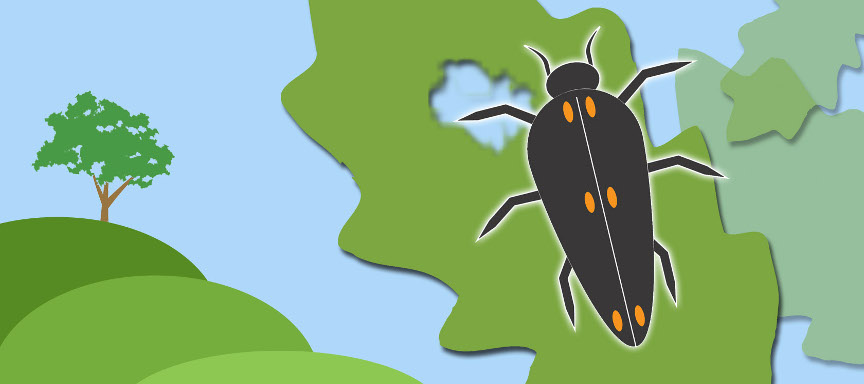
Tree Pests
Goldspotted Oak Borer
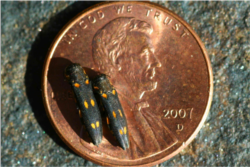
Goldspotted Oak Borer
The Goldspotted Oak Borer (GSOB) is a beetle that came to California from its native habitat in southern Arizona and northern Mexico, where the wet, monsoonal climate keeps its population in check. This beetle has become a significant threat to the beautiful, native coast live oak (Quercus agrifolia) trees that are found near locations such as Oak Canyon Nature Center, as well as other oak tree species in Southern California. The pest was first found in Orange County in 2014 after severe infestations were seen in San Diego and Riverside counties. OCFA was awarded a California Department of Fire and Forestry Protection (CALFIRE) grant funded through the California Climate Investments (CCI) for the Invasive Tree Pest Mitigation and Fuels Reduction Project. This project, which ended in 2025, focused on the treatment and removal of GSOB and Invasive Shot Hole Borer (ISHB) infested trees to reduce the amount of dead and dying vegetation that added to the fuel load in wildland areas. While OCFA was able to reduce the threat, these pests are still present in Orange County. You can help in our efforts by not moving firewood out of local areas as this is the primary mechanism for widespread infestation. Please do your part and keep firewood local.
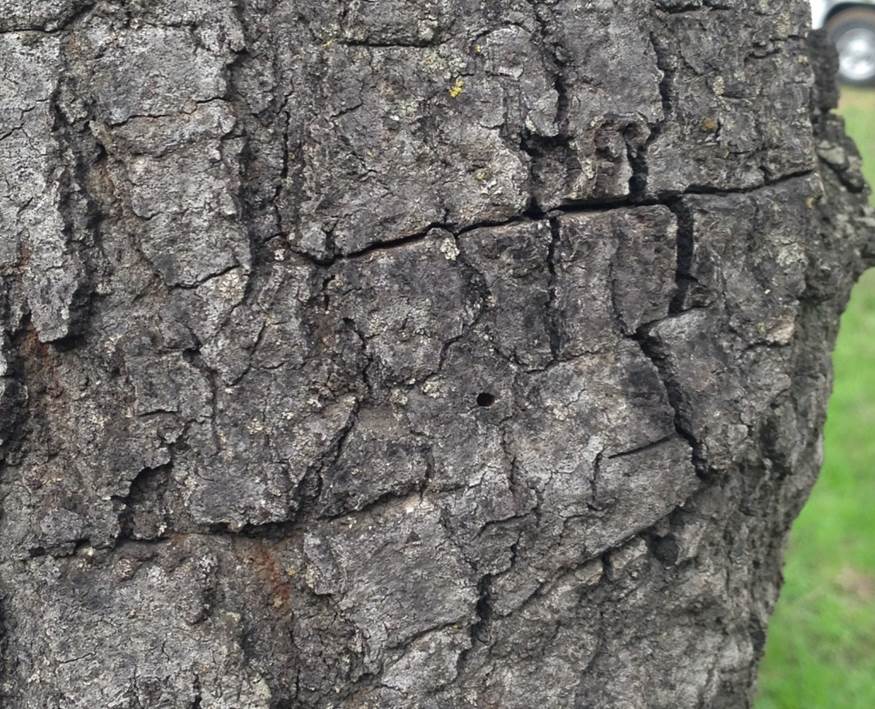
How to identify an infestation
There are several physical indicators that an oak has been infected. The GSOB prefers large red oak trees, at least 15 inches in diameter at breast height (dbh). Infected oak trees will have thinned, dying, transparent crowns in contrast to healthy oaks that have full, dense crowns that are hard to see through. Another indication of a GSOB infestation is the presence of capital “D shaped exit holes” with one straight edge and three rounded edges in the bark. These exit holes will be approximately approximately 3-4 millimeters wide and are usually found at the base of the tree, within about the first 5 feet of height. Infested trees may also show signs of severe cracking into panels of bark as well as dark wet stains or red sap oozing through the bark. If you would like to submit a report of suspected Goldspotted Oak Borer infestation, please click here.
After potentially infested oak trees have been identified, scientists will visit the site to officially confirm the presence of GSOB before a treatment plan can be activated.
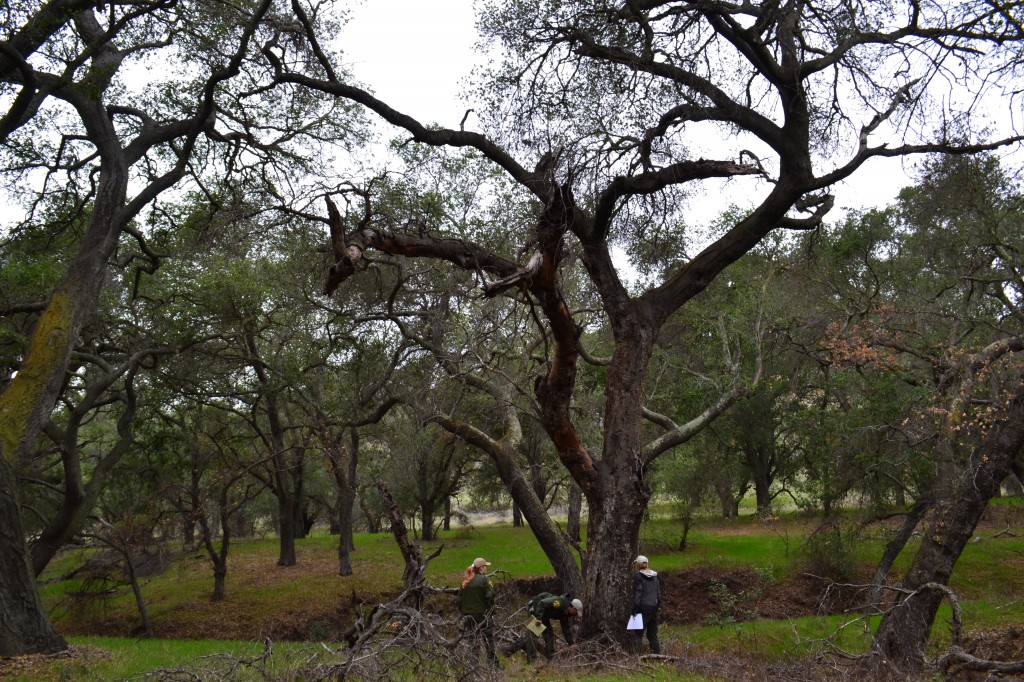
Thinned and dying oak crowns caused by the GSOB
Options for treatment
Heavily infested trees (showing 100 or more D shaped exit holes) likely cannot be saved and pose significant hazards for the build up of wildfire fuel and falling limbs, particularly near structures. These trees should be removed. Grinding is the preferred method to ensure that the infestation does not spread and should be done from October through April, prior to the adult emergence. The trees should be cut into narrow strips no more than 3 inches long, 1 inch wide, and 1/2 inch thick in order to destroy all life stages of the GSOB. These specifications require large, specialized equipment and should only be undertaken in conjunction with official authorities. Another option is to contain the GSOB in chopped wood using either large, clear tarps or fine wire-mesh screens (1 millimeter). Trials using certain systemic and topical pesticides to protect oaks that are not yet severely affected have shown promise, but conclusive results are not yet available.
Polyphagous Shot Hole Borer
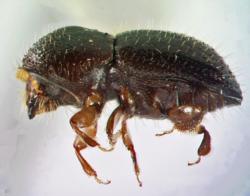
Polyphagous Shot Hole Borer (PSHB)
How to identify an infestation
Symptoms of an infestation differ among tree species, however in most trees a perfectly round entry hole of less than 0.1 inches in diameter is present. Infection can cause wet and oily dark stains surrounding the entry holes, discolored wood, leaf discoloration and wilting, and dieback of entire branches. A white crusty ring of sugar can also be found on box elders and avocados. More specifics on symptoms in different species can be found here.
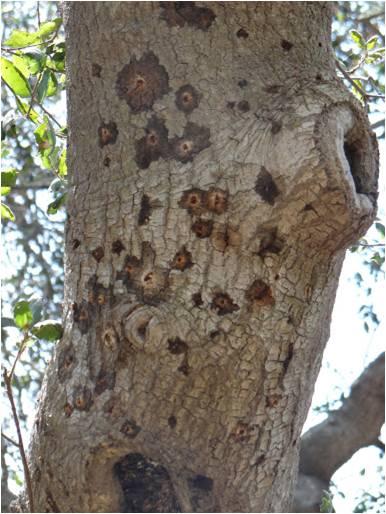
Entry holes on Coastal Live Oak. Credits: Prof. Akif Eskalen
How to manage an infestation
The most important thing to remember when dealing with a PSHB infestation is not to move infected wood and always use firewood locally. This will greatly reduce the spread of the pest into healthy vegetation. If trees are found to be infested, the preferred method of removal is to chip the trees to pieces smaller than 1 inch. Tarping infected wood can also limit the spread of the PSHB. In order to assist in official efforts to monitor and combat the infestation, please contact your local Agricultural Commissioner’s Office.









